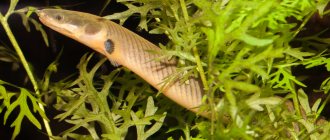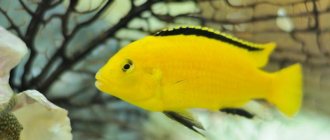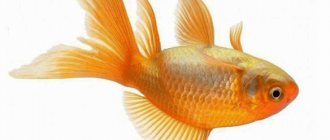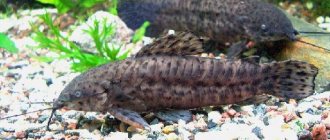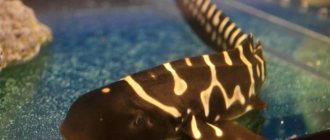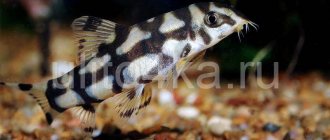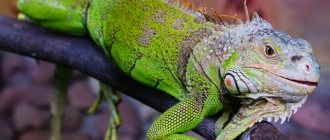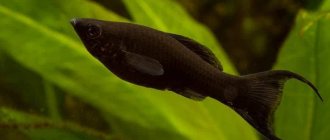Home/FISH/Harmony in an aquarium with predators
Predatory aquarium fish attract the eye with their exotic appearance and behavioral characteristics. They jealously guard the territory, quickly rushing to attack. It is very interesting to watch such active pets. Some species can recognize the owner and react to his approach.
Popular types
The list of popular species of predatory fish suitable for keeping in an aquarium includes the following names:
- piranha;
- Tetradon dwarf;
- sacbranch catfish;
- cichlazoma eight-striped;
- kalamoicht kalabar;
- acanthophthalmus;
- striped shilb;
- astronotus;
- Belonesox;
- Anabass
Keeping some types of predatory fish in an aquarium can be difficult for a beginner, so before purchasing a pet you should carefully study the description of this species and the features of caring for it.
Piranha
Piranhas are the most dangerous fish for an aquarium. They are highly aggressive, so they should be kept in a species aquarium. Piranhas are characterized by a laterally flattened body up to 30 cm long, dark gray in color with light speckles; the lower part of the body is orange-red. The lower jaw is pushed forward, and sharp teeth are located in the oral cavity. Piranhas are kept in groups of 6 individuals in tanks with a volume of 500 liters or more. The main food is finely chopped poultry and live fish; Piranhas are also given squid, earthworms, and tubifex. With a lack of food, piranhas begin to hunt neighbors, including their own relatives.
Tetradon dwarf
The dwarf tetradon is characterized by an original appearance that distinguishes it from other freshwater fish. The body has an elongated cylindrical shape, the color is golden yellow with large black spots. The size of adult individuals does not exceed 2.5-3 cm. When in danger, the fish are able to inflate to a spherical state. The main diet of tetradon is snails; These fish are also fed with bloodworms, daphnia and artemia. Tetradons can be aggressive towards other fish, so they should be kept in a small group in a species aquarium. This species is undemanding regarding water parameters, but the water must always remain clean.
Sacbranch catfish
The sacbranch catfish is a fish 30-50 cm long, black in color. Along the body, from the gill slits to the tail, there are special bags in which the catfish stores water. Thanks to this feature, the fish can survive on land for up to several hours. At the base of the pectoral fins there are poisonous glands ending in spines. The venom is dangerous to humans, so care should be taken when handling sacbranch catfish. The catfish is able to get out of the aquarium even through a small gap, so the tank must be tightly closed with a lid. The fish leads a crepuscular lifestyle. Possible to keep together with large cichlids.
Cichlazoma eight-banded
Cichlazoma eight-striped is a predatory aquarium fish that grows up to 25 cm in length. The color is extremely attractive: there are small shiny blue and green specks on a black background. The species is characterized by aggressive behavior, so adult cichlases are kept in pairs in individual aquariums with a volume of 200 liters or more. Aggression can be reduced by equipping the pond with shelters and lowering the water temperature to 25°C or less. Cichlazomas love to dig the soil, so plants must be planted in pots. Cichlids are fed with any live and frozen food, as well as ready-made diets for cichlids.
Kalamoicht calabarensis
Kalamoicht calabar has an elongated snake-like body up to 40-90 cm long, brownish-olive in color with large scales. A distinctive feature is the presence of lungs, thanks to which the fish can stay on land for up to 8 hours. The fry have external gills. To keep a group of 3-5 kalamoichts you will need a tank with a volume of 250 liters or more. The container must be tightly closed with a lid, since fish are able to get out even through small cracks. Kalamoikhtas are non-aggressive and get along with any peaceful species of fish. They are fed with any live and frozen food of animal origin.
Acantophthalmus
Acantophthalmus is characterized by an elongated serpentine body up to 12 cm long with a striped color. There is a spine under the eye, with the help of which the fish defend themselves from predators and move in narrow spaces. Breathing is intestinal and cutaneous. Acanthopthalmus are kept in containers of 100 liters or more with a thick layer of soil at the bottom, into which the fish burrow. It is necessary to place several shelters in the aquarium, and also equip the tank with a lid to prevent the fish from jumping out of the water. The species is omnivorous and undemanding to water parameters. Acantophthalmus are peaceful fish that can get along with any non-aggressive species of fish and shrimp.
Shilb striped
Striped shilb is a dark gray catfish with silver longitudinal stripes, reaching a length of 30 cm. The pectoral fins have spines that communicate with poisonous glands, so the fish must be handled with care. Shilbs are kept in groups in spacious aquariums. The species is non-aggressive and gets along with peaceful, proportionate neighbors. The aquarium requires powerful filtration and aeration, as well as weekly changes of 1/3 of the volume with fresh water. Small fish, bloodworms, coretra and ready-made dry mixtures are suitable as food.
Astronotus
Astronotus is a large and massive predatory fish, reaching a length of 35 cm. It has a well-developed intellect and is able to recognize its owner. Natural color is dark gray with rusty red spots on the sides; Breeders have developed morphs of various colors. Astronotus are kept singly or in pairs in individual aquariums with a volume of 400 liters or more or with comparable neighbors. These fish are fed small fish, live and frozen invertebrates, and ready-made cichlid formulas. Astronotuses love to dig the ground, dig up plants and move decorations, so equipment and decorative elements must be securely fastened.
Belonesox
Belonesox is a viviparous carnivorous fish of a silver color with black specks on the sides, reaching a length of 12-20 cm. A distinctive feature is an elongated, pointed head, similar to a pike. In the absence of food, whitefish are capable of eating other fish and their own relatives, so they should be kept in individual aquariums with a volume of at least 100 liters. The reservoir should be planted with plants and equipped with shelters. The water should be slightly acidic (pH 6.2-7.8) and warm (24-30°C). Whitefishes are fed small fish, insect larvae and other invertebrates.
Anabas
Pineapple is a labyrinth fish up to 20-25 cm long, gray in color with black spots and stripes on the sides. A distinctive feature is the powerful pectoral fins and spines on the gill covers, with the help of which the fish moves on land. Thanks to the labyrinth, the climbing perch can stay on land for up to 8 hours. Pineapples are aggressive fish, so they are kept singly or in pairs in species aquariums. Fish can jump out of the water, so the tank must be covered with a tight lid. Pineapple leads a crepuscular and nocturnal lifestyle and during the daytime hides under snags and other shelters. The species is omnivorous, but prefers live food.
Pineapple or creeper
Beautiful predatory aquarium fish Anabass (Climb family) are freshwater inhabitants with a bony skeleton and a laterally flattened body, the size of which reaches 22 cm.
The color of the Pineapple is gray-beige with a greenish tint. At the same time, the back is darker, and the belly is yellowish.
An interesting feature of the species is the ability to live outside a body of water for several days. These fish are quite jumpy and can crawl on land. Therefore, be sure to cover the aquarium so that you don’t have to look for your pets throughout the apartment.
The Crawler's diet should consist of small fish, fry, and boiled rice. This is a school predator that is comfortable in a family of 4–5 individuals. In this case, the aquarium should have a volume of 150 - 200 liters.
Content Features
Aquarium predator fish require a large reservoir. Most carnivorous fish have an aggressive disposition and territorial behavior, so they should be kept in species-specific aquariums. Fish of similar size and temperament are suitable as neighbors for peace-loving species. The pond should be equipped with shelters and dim lighting should be created.
Feeding predators is carried out 2-3 times a day in small portions. Fish that swallow large prey whole are fed 3-5 times a week. Live fish, earthworms, mollusks, tubifex, bloodworms, brine shrimp, coretra and other invertebrates are used as feed. It is not advisable to feed mammalian meat, as it is poorly digested and leads to fish diseases.
Water parameters for most types of tropical fish are similar: temperature 22-30°C, pH 6.5-8, dH 8-20. The reservoir must be equipped with a powerful filter and aeration system. Residues of animal feed in water quickly decompose, releasing toxic substances. In this regard, it is necessary to clean the aquarium weekly with a siphon and replace 1/5-1/3 of the volume with fresh water.
Krenicichla cordis punctata
This is a predator from the Cichlid order that is not too demanding in terms of living conditions, capable of growing up to 24 cm. Its favorite food is small live fish, tadpoles, worms, and fresh beef.
A pair of Crenichl feels comfortable in a container of 400 liters or more. These are quite angry and very active representatives of their species, who require a lot of space for games and chasing prey. In a cramped aquarium, there is a danger of injury to fish, which during the hunt often crash into decorative elements of the reservoir.
Parrot
Red, orange and yellow aquarium predators are parrot fish. They are cute, relatively peaceful (compared to other cichlids) and unpretentious in their diet.
The smallest of the listed brothers. Body length – 20 centimeters. Parrots are gregarious, as we said above. A family of 5 individuals needs 250 liters of water.
How to feed your pets? Dry food for these representatives of cichlids, frozen food and live food. Tubifex, coretra, bloodworms - the fish eat all this with great pleasure. They will not refuse meat and shrimp. Only the delicacy needs to be pre-cooked and cut into small pieces.
Is it possible to get offspring from parrots? Alas, like many cichlids, they do not want to become parents in artificial conditions. More precisely in aquariums, because only very experienced aquarists who know their characteristics breed parrots. The main feature of these fish is that the males are sterile and cannot fertilize the eggs.
Reproduction
Aggressive attacks towards others in predatory fish intensify during the spawning period. To reduce the intensity of passions, the couple is placed in a separate container.
The diet of future parents should include more protein foods.
The birth of fry can be expected after 1 – 2 weeks. At the same time, some types of fish can show aggression towards their offspring, so they are immediately placed in a common aquarium.
Spotted Indian knife
The fish, which has such an unusual name, is quite large, by aquarium standards, in size and has an evil character. Often its victims are relatives who have encroached on “foreign” territory.
The lifestyle of this predator is nocturnal, so it should be fed in conditions of minimal illumination of the reservoir. The diet of the Indian Knife may include tadpoles, small fish, and fry. Its size reaches 30 cm, so the capacity should not be less than 150 - 200 liters for each individual.
So that the fish can hide somewhere during the day, the bottom of the aquarium is equipped with grottoes, driftwood, and ceramic pots.
Calm aquarium fish. Peaceful aquarium fish
Peaceful and calm aquarium fish
Representatives of the following families are distinguished by their calm behavior and peaceful disposition:
- Catfish. Almost all catfish are very friendly. They swim along the bottom and have nothing to share with other inhabitants of the aquarium, who spend most of their time in the water column. Among the most popular peaceful catfish are speckled catfish, corydoras, glass catfish and ancistrus
- Characinaceae. The characin family includes small, friendly fish that live in schools. As a rule, they have quite attractive bright colors and do not require special care. The most common aquarium characins in our country include thornets, neons, tetras and pristellas
- Cyprinids. Peaceful representatives of the carp family include aquarium fish such as zebrafish, barb, cardinal and rasbora
- Labyrinthine. This subgroup of fish differs from the rest in the specific structure of their body. This explains the unusual shape of the fish. The most popular aquarium fish of this family are gourami, bettas, macropods and lapius.
- Cichlids. In general, cichlids are considered quite capricious and aggressive fish. However, even among them there are a number of fish that can get along with other types of fish. To properly place cichlids in the same aquarium with other fish, it is worth taking into account their habits and equipping special burrows and shelters in it. The following representatives of the cichlid family can be called quite friendly: blue dolphin, cichlasoma and aulonocara
Exotic aquarium fish, photos with names
Among those fish that were mentioned above, there were a lot of exotic fish. But these are not all the strange fish that you can keep right at home today. Here are the names and photos of the most beautiful and unusual exotic aquarium fish:
Elephant fish
glass perch
Tetraodons or four-teeth
Macrognath
Silver arowana (dragon fish)
Skat Motoro
Red-bellied Piranha
Mastocembelus redstripe
Mastocembelus armatus armored
Botia marble
Fish knife Khitala
Leporin tape
Arabian butterfly fish
Tamarin yellow
Florida armored pike
Surgeon olive
Chromis
Royal Gramma
Gramma blackhead
Queen Nyasa
Falsechromis violet
Falsechromis Friedman
Fundulopanax
Heufrich's Nemateleotris
Bleeker's Parrotfish
Green clown goby
Gymnothorax funebris or green moray eel
Snipe wrasse
Bristle-tailed unicorn
Rose-tailed Triggerfish
Thalassoma lunarum
Green tamarin
Acantophthalmus
Compatibility
Fish with identical habits should be kept in the same container with predators. Herbivorous and omnivorous representatives of underwater fauna can be placed in the same aquarium, provided they are larger in size. Otherwise they will be eaten very soon.
The best option is to keep predatory aquarium fish of the same species in a separate container.
But there are representatives of predators who show aggression towards their “relatives”. It is better to house such fish together with larger herbivorous species.
For carnivorous pets, a small fish is food, so an unenviable fate awaits it if it is in the same container with predators.
Unpretentious aquarium fish
Unpretentious aquarium fish
The least exotic fish and small-sized fish have always been considered the most unpretentious. Here are the Top 15 such fish:
- Guppy
- Swordtails
- Pecilia
- Mollies
- Catfish corridors
- Characin tetras
- Ternetia
- Danio rerio
- Torakatum
- Gourami
- Barbs
- Cardinals
- Cockerels
- Macropods
- Neons
Snakehead
A true predator, both in nature and in captivity, is the snakehead. In its natural habitat, the snakehead eats all the fish it can handle. It has the unique ability to breathe atmospheric oxygen.
The head of the fish is covered with snake-like scales, and the body is elongated. For these qualities it received the name snakehead.
Conditions of detention:
- constant access to the surface of the water for breathing;
- soft and neutral or acidic water is recommended (5.0-7.0 pH)
- It is better to use gravel as a soil; sand is not the most suitable covering for the bottom, since snakeheads often make sharp throws and stir up the substrate;
- Shelters in the form of underwater trees and above-water vegetation are required.
Feeding is carried out mainly with live food, but it is permissible to feed with earthworms, shrimp, and fish meat.
There are 3-4 species of snakeheads in total, the most popular in the aquarium hobby are the following:
- golden cobra or orange-spotted;
- red;
- dwarf;
- imperial;
- rainbow;
- jar;
- luxurious;
- chevron;
- African;
- ocellated.
All species differ not only in appearance, but also in the requirements for the conditions of their detention.
